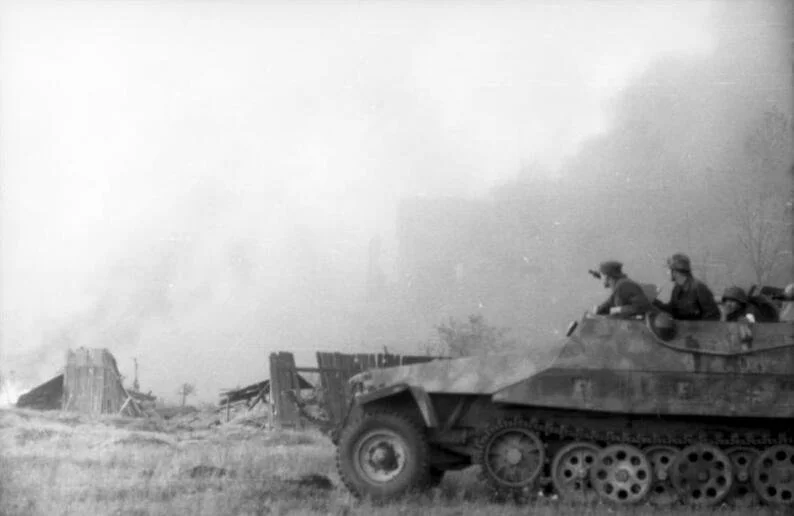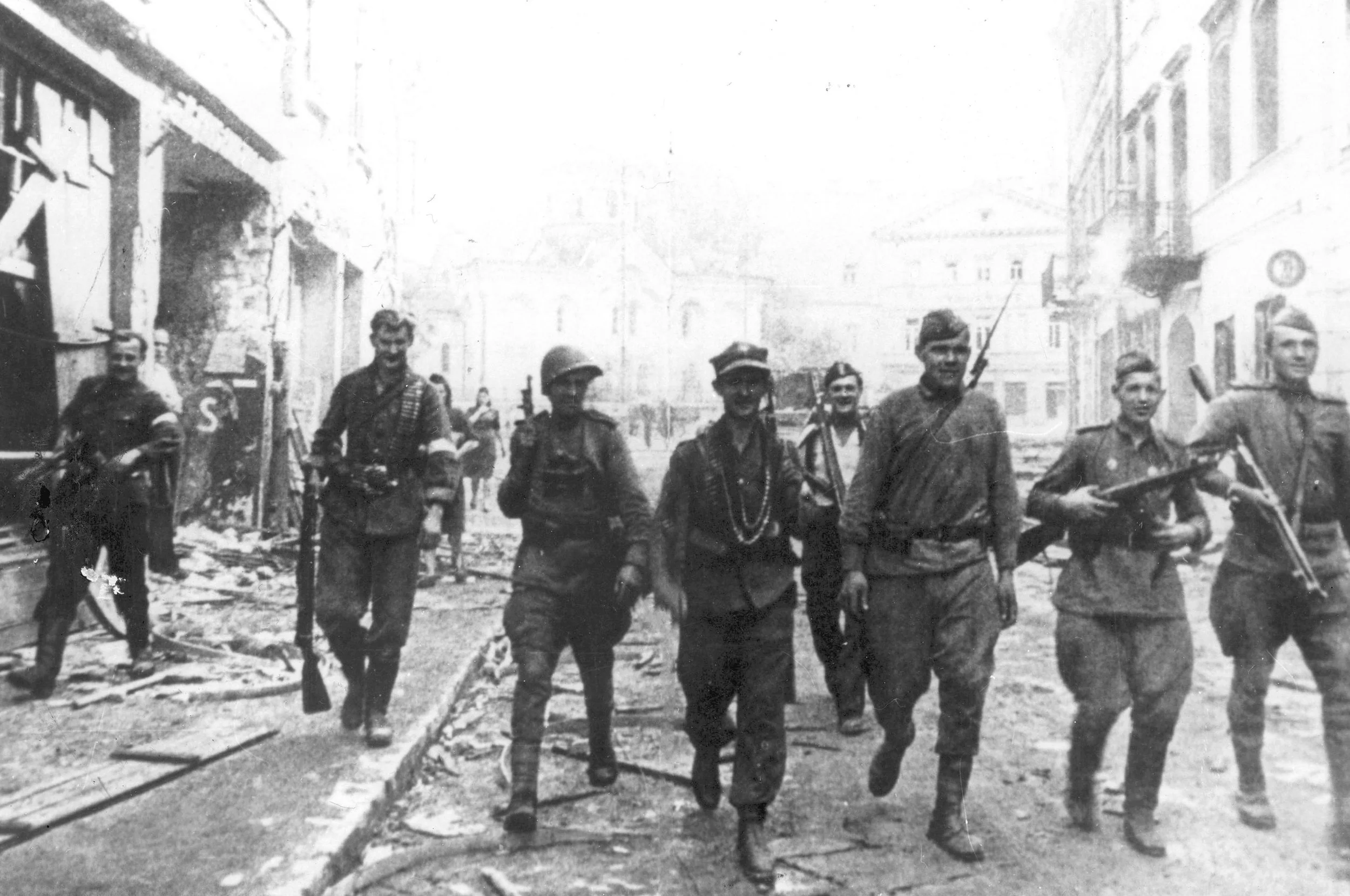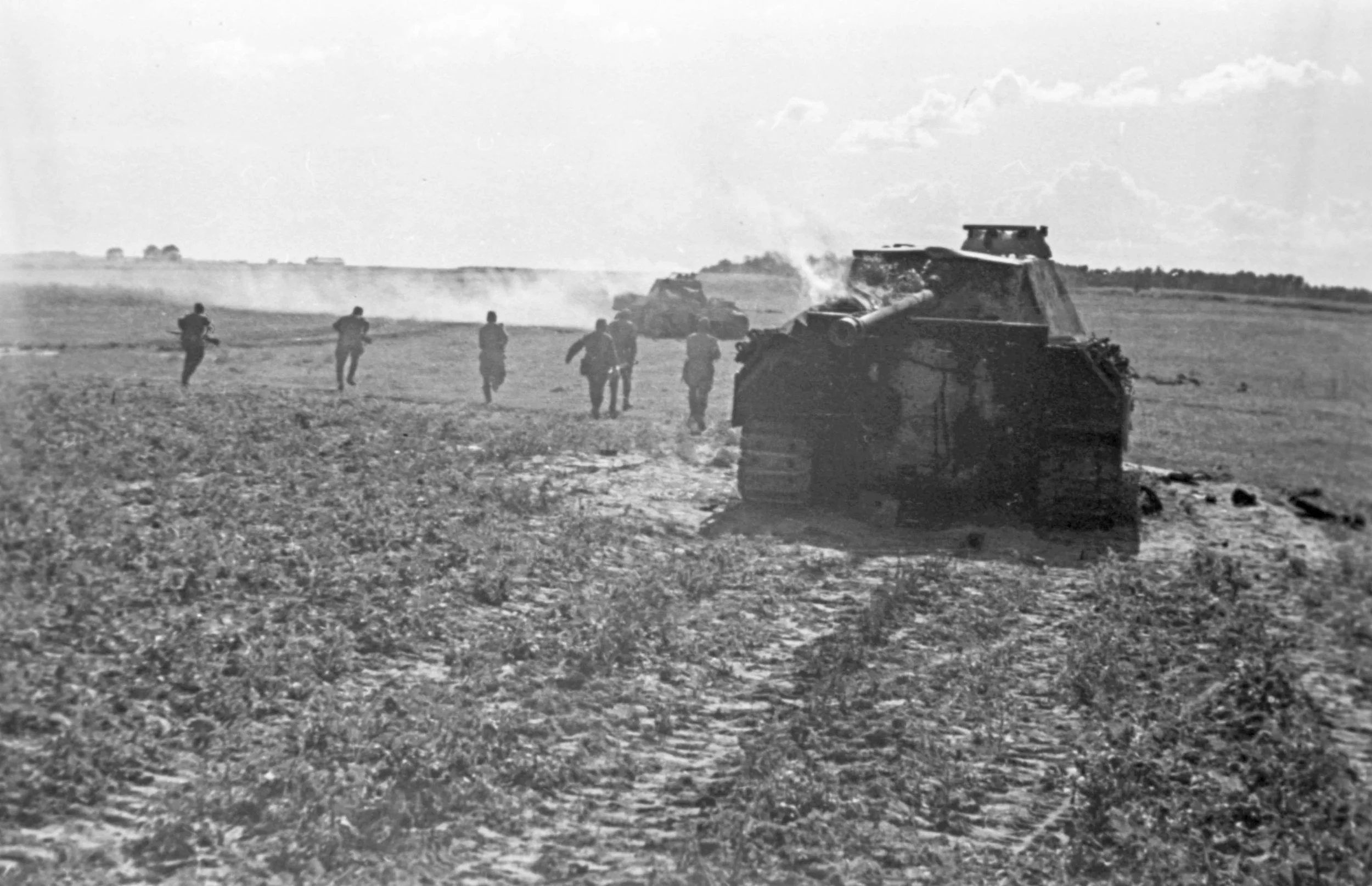Operation Bagration
Chapter 34
“If a Soviet offensive breaks out the Army will either have to go over to a mobile defense or see its front smashed”
22 June - 19 August, 1944
A German howitzer in Belarus
Even as the Allies landed in Normandy and on Saipan, the most titanic of all the operations of the summer of 1944 was building on the Eastern Front. In the wake of the Soviet offensives in both Romania and along the Baltic Coast, the Germans were exhausted and even their strongest formation, Army Group Center, was stretched thin across the vast expanse of the Soviet Union, as the Red Army prepared another major blow to match the Western allies’ landings in France.
Soviet soldiers assault an objective near Polotsk
Tactical withdrawals had continued over the spring on the Eastern Front as the Germans attempted to contract their lines and redeploy their forces to meet the Red Army’s next summer offensive. Despite these limited redeployments however, the Germans were still in control of a large salient consisting of most of the Belarussian SSR, with Soviet forces in the Ukraine and along the Baltic on its flanks. This salient was defended by Army Group Center, the largest and most powerful formation in the Wehrmacht, but by the summer most of its available reserves had been sent south as the Soviets threatened Romania.
German troops aboard a halftrack during Bagration
The Soviets, for their part, had been deliberately allowing the Germans to observe their buildup, hoping to deceive the Germans into believing that their main offensive would drive for the Romanian oilfields via Ukraine. As a result of this maskirovka, the Wehrmacht had deployed almost its entire reserve in the south, while in reality Soviet troops had been massed in such quantity to outnumber the Germans by a margin of three to one along the central sector of the Eastern Front. Regular Red Army forces had also been coordinating with partisan forces behind the German lines to ensure maximum disruption of the German rear when the storm finally broke.
A Soviet heavy artillery battery
And break it did on the morning of 22 June, 1944, as an artillery barrage of enormous proportions tore apart Army Group Center’s lines. Penetrations followed across the entire front, with Red Army tanks and infantry crashing through the shell-shocked defenders in multiple locations, with the German 4th Army being heavily engaged near Mogilev in the center of the Belarussian Bulge. Concurrent operations were also launched by the Soviets in the north around Vitebsk and in the south at Bobryusk.
A Soviet AT gun crew in action near Vitebsk
Within days the Germans were enveloped at Vitebsk, with the Fuhrer denying all requests for tactical withdrawal and insisting that his forces stand and fight. In short order, the 3rd Panzer Army was eviscerated by the attacking Soviets as the 4th was pummeled in the center, and while the Fuhrer’s headquarters eventually relented and authorized withdrawals, it was by now too late. As attempts were made to restore the German front lines, the 9th Army was effectively destroyed, and within a week the 4th Army and the 3rd Panzer Army were on the brink. As the situation deteriorated the commander of Army Group Center, Field Marshal Ernst Busch, was relieved by Hitler, replaced with Field Marshal Walter Model, the “Fuhrer’s Fireman”, who was known to be able to salvage hopeless situations.
Red Army troops clearing a street
As June came to a close, the Germans found themselves falling back toward the Beresina River, until the Soviets reached it on 28 June. By this point it was apparent that the Soviet objective was to envelop Army Group Center and liberate Minsk, which was acomplished on 3 July, with the Center by that point in a state of collapse. Panic had begun to set in as German units desperately moved westward, being overrun and crushed by the Red Army one by one. Attempts to move reinforcements from Army Group North Ukraine to salvage the situation had negligible effect.
German panthers in Belorussia
Desperate attempts to reorganize the chaotic German lines by Model proved fruitless, as in the aftermath of the fall of Minsk the Red Army offered no respite, with the Germans being pressed back toward the Polish border and the Baltic. Attempts to redeploy Army Group North to link with Center proved equally unsuccessful, with the Germans unable to close the gab between their formations and allowing the Soviets to continue their penetrations, driving toward the Lithuanian capitol of Vilnius, which was enveloped by 8 July.
Soviet soldiers remove German sgns in Grodno after its liberation
By mid July Army Group Center was managing to get its forces reorganized, as the Soviets’ supply reserves began to run low. Despite this, the main reason that the pressure was beginning to ease on Center was that the Stavka was taking advantage of the gap between Center and North to attempt to isolate Army Group North by reaching the Baltic coast. This too was accomplished on 31 July, isolating the bulk of Army Group North in Lativa, although German counterattacks managed to restore the connection of the fronts, although only for a time, as Hitler refused to allow the battered force to withdraw.
Soviet and Free Polish troops on the streets of Vilnius
Additionally in the center, the 1st Belorussian Front had continued their own attacks in late July, driving into Poland and capturing Lublin and Brest-Litovsk, reaching and in some areas crossing the 1939 partition line. By early August the Soviets had reached the Vistula and established bridgeheads across it, and found themselves at the gates of the Polish capitol of Warsaw. Even more concerning to the Germans, for the very first time the territory of the Reich was violated by the Red Army, as a toehold was established in East Prussia.
Soviet soldiers fighting in the forests near Warsaw
By the end of Operation Bagration, the Red Army had advanced over 400 miles, and had all but expelled the Germans from the USSR. Now, with the Soviets positioned along the frontiers of the Reich itself they set about preparing for their full scale invasion of Germany, all while Germany’s Axis allies in the East teetered toward collapse. The Germans’ largest military formation, Army Group Center, had all but ceased to exist, and the Eastern Front was almost entirely broken open, with the Soviet advance only stopped by their finally running out of supplies. Concurrent with the reopening of the Western Front at Normandy, this signaled the start of the last major phase of the European War.
Soviet infantry pass knocked out German panther tanks













